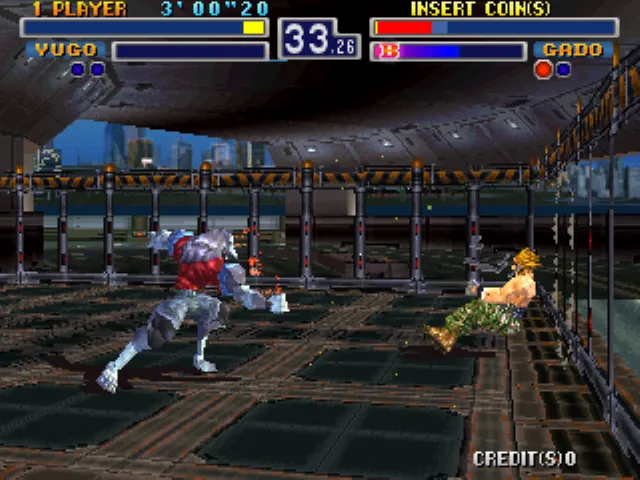
I had previously talked about Bloody Roar 2, fondly remembered by many as an awesome fighting game for the Arcades and Playstation that not only allowed you to transform into a "beast form" for a cool factor and extra attacks, but also had a lot of unique flair in the presentation which is something that can be said from a lot of games in the 90s with the need of standing out from competitors.
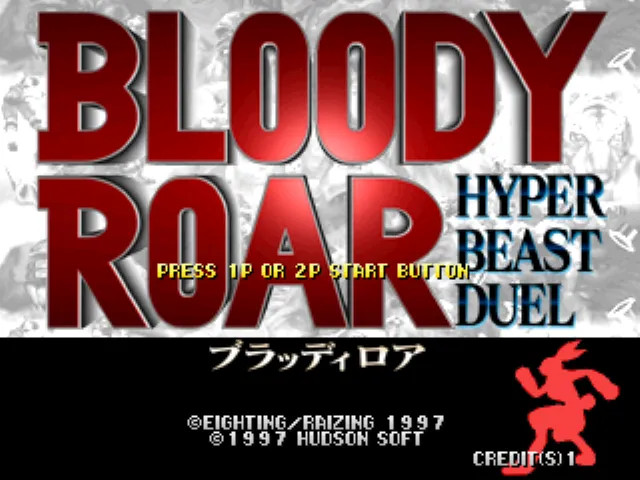
That said, the first game does also deserve a lot of merit, not simply from having started the series at all, but also having done so with a great base and enjoyability, being a quite solid first entry compared to other big fighting game franchises (despite being quite late in the party), like Tekken and Virtua Fighter 1 (which had the very basic set), and even Street Fighter (which if you haven't heard of, the first game is...incredibly rough). That is, if you ignore the fact that the international Arcade release was called...Beastorizer. (man, good thing they got rid of that for the PS1 version and everything that followed 😅)
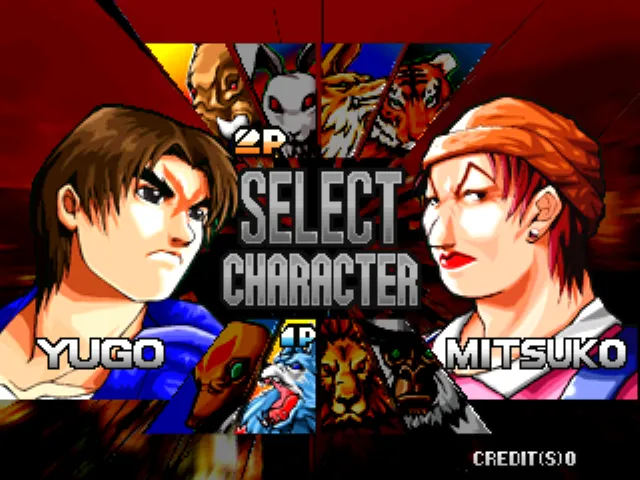
While there are no super attacks/Beast Drives in this game, the PS1 version would introduce a "Rave" mode which let you cancel any moves into themselves and so on (which was added as an extra mode in PS1 BR2, and added as a different mechanic in future games). Other than that, most of the gameplay cues seen in Bloody Roar 2 were actually present since the first entry here. However, the roster was somewhat different from the next games, with Fox, Greg and Mitsuko only showing up in this one game while some few other mainstays weren't introuduced yet.

To the credit of the developer 8ing/Eighting (which was named Raizing back then), this is a really solid 3D fighting game even when it was their first (under Hudson's production) before they were having a hand in popular games like Tatsunoko VS Capcom, Marvel vs Capcom 3, and as of recently, DNF Duel. Of course, Hudson Soft, most known for developing most Mario Party games and the Bomberman franchise, had a quite good eye on how to design a fighting game with an unique twist.
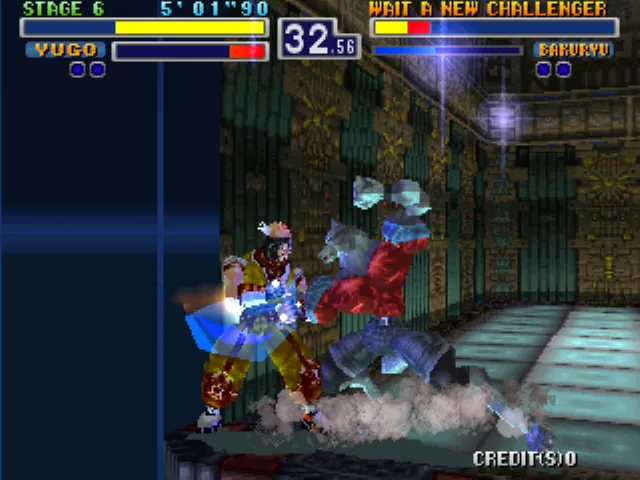
While only displaying at 320x240, it is somehow better than Bloody Roar 2 in the stage detail department, as a mix of sprites and 3D polygons were used for some rather impressive backgrounds for PS1 hardware while keeping 60fps. The game also has a rather unique camera movement and angles for some special grabs and on a knock-out; specially if you end up knocking them out of the stage as they break the walls and fly outside. The music is a bit more of a mixed bag at least for a fighting game, as most tracks are fine but not too energetic or particularly impressive, though the final boss theme is both pretty good and fitting for the occasion.
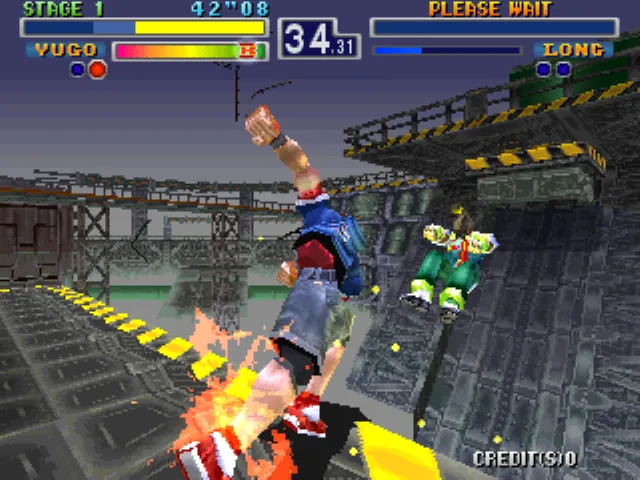
Speaking of final bosses, Gado was a normal character here (final boss in BR2), while Long's moveset and appearance from here was used as the base for Shenlong in BR2 (extra boss), and Uriko, who is Mitsuko's daughter, was the final boss here after being brainwashed and experimented by an evil corporation, transforming from a kid into a more powerful form...and when you do enough damage, transforming into a huge behemoth that even causes the stage to activate an emergency quarantine. It is a rather unique design for a final boss in fighting games (and specially for the Bloody Roar franchise)
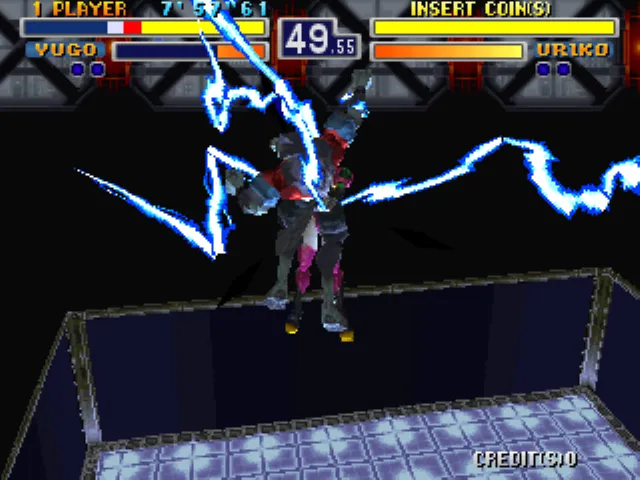
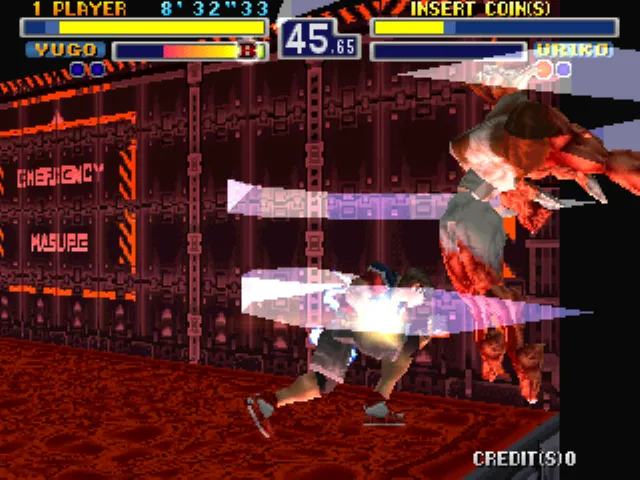
Another beloved entry for the Bloody Roar fans, and one first entry that already had a lot going for the future, many aspects from it would be directly or indirectly influential in future games, like the PS1 Rave mode, Uriko's boss form and Bakuryu's design here being reworked for Bloody Roar 3 (Hyper mode, and hidden characters Uranus and Kohryu). In any case, to play this as another arcade fighting game to run through casually or to play with friends, it does a good job just like its sequel.

Thank you so much for reading! If you want me to review more retro arcade games (or fighting games, I still know a handful of those that I could talk about 😎), let me know in the comments! You can also check some of my previous reviews here:
Street Fighter EX2 Plus - World Warrior's excelling return to 3D
Battle City - Awesome tank blasting on the NES/Polystation!
Tank Force - Battle City's Bigger Successor
Cadillacs and Dinosaurs - Capcom's obscure bombastic beat-em-up
Final Fight - A genre-defining classic in the world of beat-em-ups
Spanish translation with DeepL. All screenshots were captured by myself.
Español
Anteriormente había hablado de Bloody Roar 2, recordado con cariño por muchos como un impresionante juego de lucha para Arcades y Playstation que no sólo te permitía transformarte en una "forma de bestia" para conseguir un factor de frescura y ataques extra, sino que también tenía un gran estilo único en la presentación que es algo que se puede decir de muchos juegos de los 90 con la necesidad de destacar entre los competidores.

Dicho esto, el primer juego también tiene mucho mérito, no sólo por haber iniciado la serie, sino por haberlo hecho con una gran base y amenidad, siendo una primera entrada bastante sólida en comparación con otras grandes franquicias de juegos de lucha (a pesar de haber llegado bastante tarde a la fiesta), como Tekken y Virtua Fighter 1 (que tenían el juego muy básico), e incluso Street Fighter (que si no has oído hablar de él, el primer juego es... increíblemente duro). Eso si ignoras que la versión internacional de Arcade se llamaba...Beastorizer. (hombre, menos mal que se deshicieron de eso para la versión de PS1 y todo lo que vino después 😅)

Si bien no hay superataques/Beast Drives en este juego, la versión de PS1 introduciría un modo "Rave" que te permitía cancelar cualquier movimiento en sí mismo y demás (que fue añadido como un modo extra en PS1 BR2, y añadido como una mecánica diferente en futuros juegos). Aparte de eso, la mayoría de los elementos de juego vistos en Bloody Roar 2 estaban presentes desde la primera entrada. Sin embargo, la plantilla era algo diferente a la de los siguientes juegos, ya que Fox, Greg y Mitsuko sólo aparecieron en este juego, mientras que algunos otros pilares no se introdujeron todavía.

En honor al desarrollador 8ing/Eighting (que por aquel entonces se llamaba Raizing), se trata de un juego de lucha en 3D realmente sólido, incluso cuando fue el primero (bajo la producción de Hudson), antes de que participaran en juegos populares como Tatsunoko VS Capcom, Marvel vs Capcom 3 y, desde hace poco, DNF Duel. Por supuesto, Hudson Soft, más conocida por desarrollar la mayoría de los juegos de Mario Party y la franquicia Bomberman, tenía muy buen ojo para diseñar un juego de lucha con un toque único.

Aunque sólo se muestra a 320x240, es de alguna manera mejor que Bloody Roar 2 en el departamento de detalles del escenario, ya que se utilizó una mezcla de sprites y polígonos 3D para unos fondos bastante impresionantes para el hardware de PS1, manteniendo los 60fps. El juego también tiene un movimiento de cámara y unos ángulos bastante únicos para algunos agarres especiales y en un knock-out; especialmente si acabas sacándolos del escenario al romper las paredes y volar fuera. La música es un poco más variada, al menos para un juego de lucha, ya que la mayoría de los temas están bien pero no son demasiado enérgicos ni especialmente impresionantes, aunque el tema del jefe final es bastante bueno y adecuado para la ocasión.

Hablando de jefes finales, Gado era un personaje normal aquí (jefe final en BR2), mientras que el conjunto de movimientos y la apariencia de Long de aquí se utilizó como base para Shenlong en BR2 (jefe extra), y Uriko, que es la hija de Mitsuko, era el jefe final aquí después de que una malvada corporación le lavara el cerebro y experimentara con él, transformándose de niño a una forma más poderosa... y cuando haces suficiente daño, transformándose en un enorme behemoth que incluso hace que el escenario active una cuarentena de emergencia. Es un diseño bastante singular para un jefe final en los juegos de lucha (y especialmente para la franquicia Bloody Roar)


Otra de las entradas más queridas por los fans de Bloody Roar, y una primera entrada que ya tenía mucho que hacer en el futuro, muchos aspectos de ella serían directa o indirectamente influyentes en futuros juegos, como el modo Rave de PS1, la forma de jefe de Uriko y el diseño de Bakuryu que aquí se reelaboró para Bloody Roar 3 (modo Hyper, y los personajes ocultos Uranus y Kohryu). En cualquier caso, para jugarlo como otro juego de lucha arcade para recorrerlo casualmente o para jugar con amigos, hace un buen trabajo al igual que su secuela.

¡Muchas gracias por leer! Si queréis que revise más juegos arcade retro (o de lucha, aún conozco un puñado de esos de los que podría hablar 😎), ¡hacedlo saber en los comentarios! También puedes consultar algunas de mis reseñas anteriores aquí:
Street Fighter EX2 Plus - World Warrior's excelling return to 3D
Battle City - Awesome tank blasting on the NES/Polystation!
Tank Force - Battle City's Bigger Successor
Cadillacs and Dinosaurs - Capcom's obscure bombastic beat-em-up
Final Fight - A genre-defining classic in the world of beat-em-ups
Traducción al español hecha con DeepL. Todas las fotos capturadas por mí.